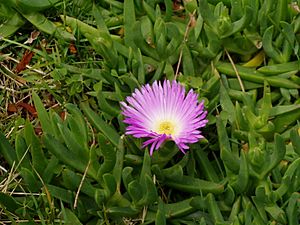Pigface facts for kids
Quick facts for kids Pigface |
|
|---|---|
 |
|
| Scientific classification | |
| Genus: |
Carpobrotus
|
| Species: |
glaucescens
|
| Synonyms | |
|
|
Carpobrotus glaucescens, commonly known as pigface or iceplant, is a cool flowering plant. It belongs to the Aizoaceae family. You can find it only in eastern Australia. This plant is a succulent, meaning it stores water in its leaves. It is a prostrate plant, which means it grows flat on the ground. Its stems can be up to 2 meters (about 6.5 feet) long. Pigface has glaucous leaves, which means they are a blue-green color. It grows pretty, daisy-like flowers. These flowers have 100 to 150 light purple to deep pinkish-purple, petal-like parts called staminodes. After the flowers, it grows red to purple fruit. Pigface usually grows very close to the ocean.
Contents
What Pigface Looks Like
Pigface is a plant that spreads out flat on the ground. Its stems can grow up to 2 meters (about 6.5 feet) long. The leaves are a blue-green color. They are shaped like a triangle if you cut them in half. The leaves can be straight or a little bit curved. They are usually 35 to 100 millimeters (about 1.4 to 3.9 inches) long. They are also 9 to 15 millimeters (about 0.4 to 0.6 inches) wide.
Pigface Flowers
The flowers of the pigface plant look a lot like daisies. They grow directly on the stem without a stalk. Each flower is about 40 to 60 millimeters (about 1.6 to 2.4 inches) wide. They have 100 to 150 light purple to deep pinkish-purple parts. These parts are called staminodes. They are arranged in three or four rows. Near the base of the flower, these parts are white.
Inside the flower, there are about 300 to 400 stamens. These are the parts that make pollen. They are arranged in five or six rows. The flower also has seven to ten styles. These are parts of the female reproductive system of the flower.
Pigface Fruit
After the flowers bloom, pigface grows fruit. The fruit is red to purple in color. It is shaped like a cylinder. Each fruit is about 20 to 30 millimeters (about 0.8 to 1.2 inches) long. It is also 16 to 24 millimeters (about 0.6 to 0.9 inches) wide.
Naming and History of Pigface
The scientific name for pigface is Carpobrotus glaucescens.
How Pigface Got Its Name
A scientist named Adrian Hardy Haworth first described this plant in 1812. He gave it the name Mesembryanthemum glaucescens. He wrote about it in his book called Synopsis Plantarum Succulentarum. Later, in 1928, another scientist named Martin Heinrich Gustav Schwantes changed its name. He renamed it to Carpobrotus glaucescens. This is the name we use today.
Where Pigface Grows
You can find Carpobrotus glaucescens in areas very close to the coast. It grows in Queensland, Australia, starting from near Mackay and going south. It also grows in New South Wales and the far eastern part of Victoria. Sometimes, people have confused it with another similar plant called C. rossii.
Pigface is also found on Norfolk Island and Lord Howe Island. These are islands off the coast of Australia. There is also a group of these plants on the Coromandel Peninsula in New Zealand. However, it might have been brought there by people, rather than growing there naturally.
How People Use Pigface
Pigface has been useful to people for a long time.
Traditional Uses
Aboriginal peoples used the fruit of the pigface plant as a food source. They would eat it to get nutrients. People say the flesh of the fruit tastes a bit like salty apples.
Other Uses
Early European explorers also used the plant. They used it to help prevent scurvy. Scurvy is a sickness caused by not getting enough vitamin C. The juice from the leaves of the pigface plant can also be used. It can help to relieve pain from bites from tiny insects called biting midges. It can also help with pain from stings by a sea creature called a Portuguese man o' war (Physalia physalis).
See also
 In Spanish: Pigface para niños
In Spanish: Pigface para niños

